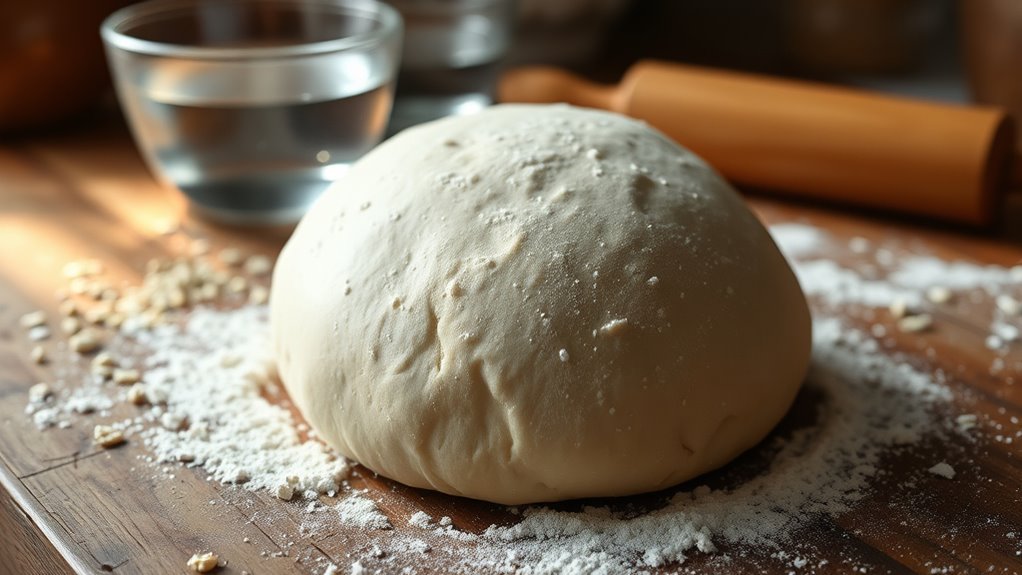To make perfect Neapolitan pizza dough at home, choose Italian 00 flour, fresh water, and quality sea salt, then mix with fresh yeast. Let the dough ferment slowly in the fridge for 8 to 24 hours, watching for signs like bubbles and slight rise. Handle it gently, shape carefully, and use your senses—smell, feel, sight—to judge when it’s ready. If you keep practicing, you’ll master the art of authentic, flavorful pizza dough.
Key Takeaways
- Use Italian 00 flour, fresh yeast, sea salt, and room temperature water for authentic dough.
- Ferment the dough slowly in the refrigerator for 8-24 hours to develop flavor and gluten structure.
- Monitor dough for gentle bubbles, slight volume increase, and a yeasty aroma to determine readiness.
- Handle the dough carefully, shaping it to preserve gluten elasticity and create a light, airy crust.
- Patience and sensory cues—smell, sight, feel—are essential for achieving authentic Neapolitan pizza dough.

Creating authentic Neapolitan pizza dough begins with understanding the fundamentals of high-quality ingredients and proper technique. The quality of your ingredients directly impacts the dough’s flavor, texture, and overall authenticity. Start with the best flour you can find—preferably Italian 00 flour—because its fine grind and gluten content create that perfect chewy yet tender crust. Fresh, clean water is equally important; it should be free of impurities and ideally at room temperature to facilitate proper dough development. Use sea salt for its mineral content and natural flavor, and opt for fresh yeast or high-quality instant yeast to ensure consistent fermentation.
Dough fermentation plays an indispensable role in developing complex flavors and achieving the right texture. When you allow the dough to ferment slowly, typically over 8 to 24 hours in the refrigerator, the yeast has time to break down the starches, releasing flavorful byproducts and resulting in a more digestible crust. Proper fermentation also enhances gluten structure, giving your pizza that characteristic chewiness while maintaining a light, airy crumb. To control fermentation, keep your dough covered and refrigerated to slow down the process, or ferment at room temperature for a quicker rise—just keep an eye on it to avoid over-proofing. Additionally, understanding the effects of fermentation temperature can help you fine-tune your process for optimal results.
Ingredient quality and fermentation go hand in hand. Using high-quality ingredients ensures the dough has a good foundation, but without proper fermentation, even the best ingredients won’t reach their full potential. During fermentation, watch for signs like gentle bubbles on the surface and a slight increase in volume; these indicators show your dough is developing correctly. When you punch down your dough after fermentation, you release excess gas and prepare it for shaping. This step is essential for achieving that characteristic airy interior and a thin, blistered crust. Proper fermentation techniques also help in managing the dough’s moisture content, leading to more consistent results. Moreover, controlling fermentation conditions can prevent undesirable off-flavors and ensure a clean, authentic taste.
Timing and temperature are key. Don’t rush the fermentation process; patience results in richer flavors and better texture. If you’re short on time, a shorter, warmer fermentation can work, but the slow, cold fermentation consistently yields superior results. Always use your senses—smell, sight, and feel—to judge the dough’s readiness. It should smell slightly yeasty but pleasant, and when you stretch it, it should be elastic and resilient without tearing easily. Additionally, using proper fermentation techniques can significantly improve your dough’s flavor and texture, making the process more predictable and successful.
Frequently Asked Questions
Can I Use Gluten-Free Flour for Neapolitan Pizza Dough?
You can try using gluten-free alternatives for neapolitan pizza dough, but keep in mind it may affect the dough texture. Gluten gives dough its elasticity and chewiness, which are key for authentic results. Without it, your dough might be more fragile or crumbly. To improve this, experiment with different gluten-free flours and binders like xanthan gum or psyllium husk, and adjust hydration levels to get a better dough texture.
How Long Can I Store the Dough in the Refrigerator?
Imagine your dough as a sleeping giant, resting peacefully in your fridge. You can store your dough in refrigeration for up to 24-48 hours, allowing it to develop flavor and texture. Beyond that, it may start to lose its lively spirit, affecting your pizza’s quality. Keep your dough well-covered to prevent drying out, and plan your baking accordingly to enjoy that perfect, fresh-tasting crust every time.
Is It Necessary to Use a Pizza Stone?
Using a pizza stone isn’t necessary, but it can make a difference. A pizza stone helps you achieve a crisp, evenly cooked crust by absorbing and retaining heat, which allows you to reach higher oven temperatures. Place the stone in your oven before preheating, and you’ll get a more authentic Neapolitan-style pizza. It’s a handy tool that improves your crust’s texture and overall quality, making your homemade pizza even better.
What Are Common Mistakes to Avoid When Making the Dough?
When making dough, you should avoid overmixing, which can make it tough and dense. Also, don’t rush the fermentation process; insufficient fermentation leads to flat, flavorless crusts. Use gentle mixing to incorporate ingredients and give your dough enough time to develop flavor and texture. Remember, patience is key—allow proper rising, and you’ll end up with a light, airy, and delicious pizza crust.
Can I Make the Dough in Advance for Multiple Uses?
You can definitely make dough in advance for multiple uses. Just focus on proper dough fermentation and storage techniques. After mixing, let the dough ferment in the fridge for up to 48 hours, which enhances flavor and texture. Use an airtight container to prevent drying out. When ready to use, take it out and let it warm slightly before shaping. This way, you’ll enjoy fresh, flavorful pizza every time.
Conclusion
Now, as you gently shape your dough, imagine a delicate snowflake transforming into a fiery, bubbling masterpiece in your oven. The simple act of mixing flour and water becomes an art, blending patience with passion. With each perfect crust, you craft more than pizza—you create a warm, inviting slice of Italy’s soul. So, embrace the process, cherish the imperfections, and let your homemade Neapolitan pizza bring a little magic to every bite.









